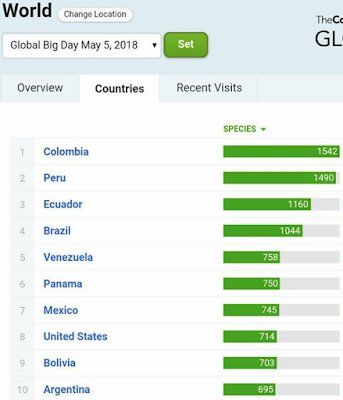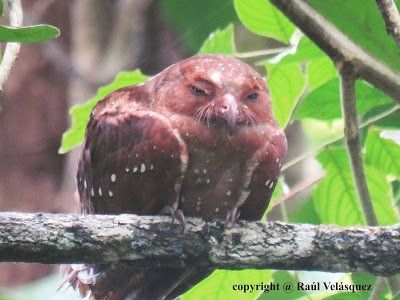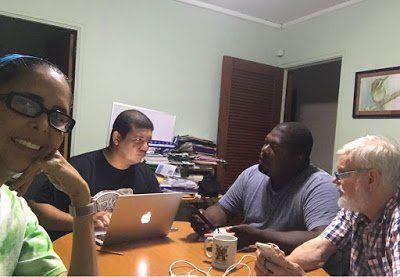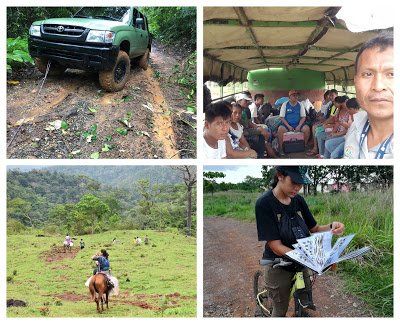Global Big Day
After all the organization and enthusiasm raised during the weeks previous to this year Cornell's Global Big Day (you can read about it here), it was clear that Panama's participation would be no less than spectacular! And what a Global Big Day it was! Clearly, the participation was way higher than previous years... just notice how filled was the participation map for that day!
The Global Big Day started, for some, at the very first second of May 5th... by spying feral Rock Pigeons at their roosting site in Panama City for example (yes Rolando, I'm talking about you) or starting to calling out owls in the darkness. Soon, more and more teams started to join the event, and the list of species for Panama started to grow . There were people counting birds almost everywhere! Towns, gardens, forests, beaches, marshes, mountaintops, deserts (not actual deserts in Panama, but anyway) and pelagic waters were all covered! To make the tale short, we achieved all our main targets for the day: we beated our previous record by finding 750 species for a single day in Panama, we are number one for the region (and for North America!) and 6th place worldwide... W O W ! ! !
But most important, we definitively destroyed our previous participation numbers! We sent six times more checklists than the previous years, and more than 700 volunteers travelled the country looking for birds!

Most of the "Macro Teams" recorded unique species for the national total and, in fact, 106 species (14% of the total) were reported by only one team or individual, showing the impact that single birders had in this event. Of course there were many highlights... some due to the species rarity, other by the circumstances under which these birds were recorded... I will list some of them here... but it is impossible to list all of them or the people involved in the effort to find such species in this space. If you read Spanish, a great compilation of participant organizations, photos and interesting facts for Panama's GBD can be seen in this online document prepared by Sociedad Audubon Panama.

We received interesting reports from every corner of the country, some of the rarest one included an Oilbird (!), seen by my friends of the Ocean-to-Ocean Team (Raúl Velásquez, César González and Alexander Ortega) in the foothills of Ngöbe-Buglé Comarca, the first report for western Panama; Maroon-chested Ground-Dove, Ochraceous Pewee and Silvery-throated Jay by "Los Maroons" Team leaded by Ito Santamamaría in the western highlands around Cerro Punta town in Chiriqui province.
Also in Chiriqui province, but in the lowlands of the Burica Peninsula, the "Baird's Team" recorded its namesake Baird's Trogon and Golden-naped Woodpecker; while Boris Sanjur and company of the BioCRECOBIAN - UNACHI Team, photographed the third record for Panama of Eurasian Collared-Dove, close to David City; at Cerro Algodon in the Ngöbe-Buglé Comarca, Pedro Jiménez recorded the only Yellowish Pipit of the day, the first record in more than 20 years for western Panama, also for the BioCRECOBIAN - UNACHI Team. In central Panama, Team Heliconia recorded Coiba Spinetail in, where else, Coiba Island (the only World record); Josue Ortega and company of The Naturalist Guide Panama reported Lanceolated Monklet and White-crowned Manakin in Santa Fe National Park, Veraguas province; while Ariel Aguirre et al found the Yellow-throated Chlorospingus at the forests above El Cope town, represented here by an endemic form considered by BirdLife as a distinct species (Orange-throated Chlorospingus) and Daniel Gonzáles, of the Smithsonian Tropical Research Institute Bird Collection (STRIBC) Team, contributed with the only record of Rose-throated Becard... the first confirmed nesting record for the Azuero Peninsula as you can see in this video.
At least four different American White Pelicans were recorded, a pair seen by two teams in Las Macanas marsh in Herrera province (the team leaded by Edgardo Márquez of The Naturalist Guide Panama and the team leaded by Hector Escudero of Grupo Ecoturístico Las Macanas) and another pair by the team leaded by Karla Aparicio of Fundación Naturaleza y Ciencia 507 in Punta Chame, Panama Oeste province; also at Las Macanas marsh, and also of the Fundación Naturaleza y Ciencia 507, Gumercindo Pimentel photographed two (of five) Fulvous Whistling-Ducks. The team leaded by Fernando Guardia and Arianne Magallón photographed the resident Inca Doves in Agua Fría town, close to Penonomé in Coclé province. At the foothills of Panama Oeste province, Faustino Sánchez, of the Canopy Family Team, recorded the only Snowcap of the day.

The logistic for the Global Big Day was no less impressive... just look at the transportation means that were used to arrive or leave the counting sites and during the Global Big Day. By all means the Panamanian birders reached every corner of the country... invaluable volunteer hours and kilometers traveled on foot and other means were not in vain.

From upper left corner and clockwise: Canopy Family's "HawkEagle Truck" in Pipeline Road, Gamboa. May 5th, 2018 (photo courtesy Carlos Bethancourt); Volunteer-filled truck on route to Pirre, Darién. May 4th, 2018 (photo courtesy Hayro Cunampio); Biking and birding in Garnaderita, Atalaya. May 5th, 2018 (photo courtesy Lesley Sánchez); Adopta Team's horseback riding back from Cerro Chucantí. May 6th, 2018 (photo courtesy Zabdy Samudio)
The birds were amazing, but the participation was great too! About 1300 checklists submitted placed us # 5 worldwide in participation. The vast majority of the birders sent their data through the eBird accounts of their teams instead of opening their own accounts, something we plan to improve for the next event. All the participants count; however, I would like to highlight that groups of high school students, who benefited from Cornell's "Detectives de Aves Internacional" curriculum which Katherine Araúz has been with in Panama for a while, also participated. Children are the hope of the future! And about the habitat status data, well... we are still collecting it; however, it was clear that many participants did not want to be mere passive observers and some decided to leave their counting areas better than they found them!

Escrito y fotos por: Jan Cubilla